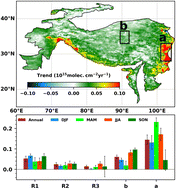Trends in atmospheric pollution in the Third Pole: analyses of tropospheric NO2 for the period 2005–2020†
Abstract
The Third Pole, encompassing Hindu Kush Himalaya (HKH) and Tien Shan mountains, has been closely monitored for the past few decades because of its deteriorating environmental conditions. Here, we analyse the spatio-temporal changes in tropospheric NO2 over the TP using satellite observations from 2005 to 2020. The highest NO2 concentrations (i.e. ≥ 1 × 1015 molec. cm−2) are found at the boundaries close to the Indo-Gangetic Plain (IGP) and Yellow and Yangtze River basins (YYRB). The analysis of the Emissions Database for Global Atmospheric Research (EDGAR v6.1) shows that the main contribution to NO2 in the region is from road transport (81%) and then the power sector (7%). Hybrid Single Particle Lagrangian Integrated Trajectory (HYSPLIT) analyses illustrate that the major regions from which air mass reaches the TP are the IGP, Southeast Asia, YYRB, Central Asia and Middle East. Our analysis reveals a positive trend in NO2 over most regions of the TP (up to 0.05 ± 0.01 × 1015 molec. cm−2 year−1) in the yearly averaged data for the period 2005–2020, which suggest that pollution is spreading even to the inner regions of the TP. Therefore, this study reveals that the inner TP, one of the most pristine regions on Earth, is getting polluted because of high anthropogenic activities within and nearby areas/cities, indicating the impact of regional development activities and socioeconomic changes in recent years.

- This article is part of the themed collection: Environmental Science: Atmospheres: Highlight India


 Please wait while we load your content...
Please wait while we load your content...